User:Acebron3: Difference between revisions
No edit summary |
No edit summary |
||
| (8 intermediate revisions by the same user not shown) | |||
| Line 2: | Line 2: | ||
== Nutrient Cycling == | == Nutrient Cycling == | ||
'''Nutrient cycling''' is the biogeochemical process of moving organic and inorganic through the environment. Nutrient cycles help soils and the life in soils receive their needed nutrients on a daily basis. Different types of nutrient cycling are vital to maintain a sustainable life for an ecosystem. [[File:nutrientsss.png|thumb|right]] simple terms, there are 3 different types of processes that take place within a typical terrestrial nutrient cycle; Litter, biomass, and soil. These three processes can be broken down into smaller scales and intertwine with each other. | '''Nutrient cycling''' is the biogeochemical process of moving organic and inorganic through the environment. Nutrient cycles help soils and the life in soils receive their needed nutrients on a daily basis. Different types of nutrient cycling are vital to maintain a sustainable life for an ecosystem. [[File:nutrientsss.png|thumb|right|The Nutrient Cycle]] simple terms, there are 3 different types of processes that take place within a typical terrestrial nutrient cycle; Litter, biomass, and soil. These three processes can be broken down into smaller scales and intertwine with each other. the size of each processes can depend on the environment. For example, a rainforest will have a big biomass and a small litter and soil. | ||
'''Importance''' | |||
---- | |||
Nutrient cycling transfers vital matter from one place to another. Some living things are unable to move to other places and nutrient cycling helps get nutrients to certain organisms. Elements can be stored in certain places within the environment and can be saved for later or can supply another organism. Nutrient cycles allow the flow and regulation of matter for organisms that need them or do not need them. It allows matter that is oversaturated in one system to move to another system where it can be useful. Nutrient cycling also makes organisms mutual because they work together to give and receive nutrients that are needed for them to sustain life. | |||
'''History''' | '''History''' | ||
---- | ---- | ||
[[File:vernadsky.jpg|thumb|left]]Vladimir Vernadsky was a geochemist and mineralogist from the Soviet Union. He was awarded the Stalin Prize in 1943 for his popular hypothesis on the Biosphere with Eduward Suess’. Vernadsky was the scientist who coined the term biogeochemistry, which is the study of physical, geological, chemical, and biological processes that govern the natural environment and the is the backbone of nutrient cycling. Many | [[File:vernadsky.jpg|thumb|left|''The Biosphere'' by Vladamir Vernadsky]]Vladimir Vernadsky was a geochemist and mineralogist from the Soviet Union. He was awarded the Stalin Prize in 1943 for his popular hypothesis on the Biosphere with Eduward Suess’. Vernadsky was the scientist who coined the term biogeochemistry, which is the study of physical, geological, chemical, and biological processes that govern the natural environment and the is the backbone of nutrient cycling. Many scientists have used different variations of the term. | ||
'''Processes''' | '''Processes''' | ||
---- | ---- | ||
[[File:nutrient_cycling.jpg|thumb|right]] | [[File:nutrient_cycling.jpg|thumb|right|The Three Main Processes in Nutrient Cycling]] | ||
'''Litter''' | '''Litter''' | ||
Litter is the process of naturally occurring matter falling into a system. For example, Trees shed their leaves in the fall and grow them back in the spring. These leaves can have useful nutrients that can transfer into the soil, giving soil some fertility. Those leaves reenter into a cycle where nutrients are passed into soil. Litter can also come from other places like precipitation. Precipitation enters into the litter system and can be passed into the soil or leave the cycle through surface runoff. Litter that stays in the nutrient cycle mostly comes from decomposition into soil | Litter is the process of naturally occurring matter falling into a system. For example, Trees shed their leaves in the fall and grow them back in the spring. These leaves can have useful nutrients that can transfer into the soil, giving soil some fertility. Those leaves reenter into a cycle where nutrients are passed into soil. Litter can also come from other places like precipitation. Precipitation enters into the litter system and can be passed into the soil or leave the cycle through surface runoff. Litter that stays in the nutrient cycle mostly comes from decomposition into soil | ||
| Line 21: | Line 27: | ||
Nutrients enter the soil through various ways. Soil is good at retaining nutrients and passing them to organisms that live in the soil. The small pores in the soil help retain the nutrients. Although soil can hold nutrients well there are still some ways where organic or inorganic matter can leave the cycle. One example is through leaching. Leaching is the process of a soluble mineral or chemical being lost from the soil as it travels into groundwater. Gravity and other factors play into leeching and take away nutrients from the soil. As that happens, certain bedrocks can emit good nutrients upward back into the soil. This uptake can benefit the soil and can enrich it. Nutrients within the soil can leave into biomass through plant uptake. | Nutrients enter the soil through various ways. Soil is good at retaining nutrients and passing them to organisms that live in the soil. The small pores in the soil help retain the nutrients. Although soil can hold nutrients well there are still some ways where organic or inorganic matter can leave the cycle. One example is through leaching. Leaching is the process of a soluble mineral or chemical being lost from the soil as it travels into groundwater. Gravity and other factors play into leeching and take away nutrients from the soil. As that happens, certain bedrocks can emit good nutrients upward back into the soil. This uptake can benefit the soil and can enrich it. Nutrients within the soil can leave into biomass through plant uptake. | ||
[[File:biomass-sources.jpg|thumb|left]] | [[File:biomass-sources.jpg|thumb|left|Sources of Biomass]] | ||
'''Biomass''' | '''Biomass''' | ||
The biomass includes things like crops, animals, municipal waster, and agricultural residues. Nutrients enter the biomass through systems like precipitation and plant uptake. | The biomass includes things like crops, animals, municipal waster, and agricultural residues. Nutrients enter the biomass through systems like precipitation and plant uptake. nutrients can be stored in the biomass through plants. | ||
'''Cycles Within And Associated With The Nutrient Cycle''' | '''Cycles Within And Associated With The Nutrient Cycle''' | ||
| Line 33: | Line 39: | ||
'''Nitrogen Cycle''' | '''Nitrogen Cycle''' | ||
The nitrogen cycle moves nitrogen in and out of soil. It is important to the life and health of the soil as it carries amino acids and life itself. Nitrogen enters the soil through nitrogen fixation, the process of which nitrogen is converted into ammonia. | The nitrogen cycle moves nitrogen in and out of soil. It is important to the life and health of the soil as it carries amino acids and life itself. Nitrogen enters the soil through nitrogen fixation, the process of which nitrogen is converted into ammonia. [[File:nitrogen_cycle.png|thumb|right|The Nitrogen Cycle]] | ||
'''The Carbon Cycle''' | '''The Carbon Cycle''' | ||
Much like the nitrogen cycle, the carbon cycle sustains all life. Carbon is the basis for soil fertility as it release nutrients for plant growth and acts like riparian zone towards harmful substances. Carbon cycles through the environment similarly to the water cycle and the nitrogen cycle. | Much like the nitrogen cycle, the carbon cycle sustains all life. Carbon is the basis for soil fertility as it release nutrients for plant growth and acts like riparian zone towards harmful substances. Carbon cycles through the environment similarly to the water cycle and the nitrogen cycle. | ||
'''References''' | |||
---- | |||
“The Nitrogen Cycle.” GeographyBase.com, Geography Bse, 16 Nov. 2017, geographybase.com/the-nitrogen-cycle. | |||
“Nitrogen Cycle The Complete Process of Biogeochemical Cycle.” Biology, 18 Jan. 2018, | |||
"The importance of Nitrogen" byjus.com/biology/nitrogen-cycle/.https://organicnz.org.nz/magazine-articles/role-importance-nitrogen-soil/ | |||
Bailey, Regina. ThoughtCo, www.thoughtco.com/all-about-the-nutrient-cycle-373411. | |||
Nutrient Cycling, sci.waikato.ac.nz/farm/content/nutrientcycling.html. | |||
Latest revision as of 18:33, 8 March 2018
Nutrient Cycling
Nutrient cycling is the biogeochemical process of moving organic and inorganic through the environment. Nutrient cycles help soils and the life in soils receive their needed nutrients on a daily basis. Different types of nutrient cycling are vital to maintain a sustainable life for an ecosystem.
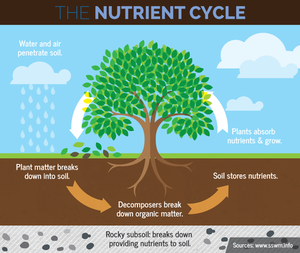
simple terms, there are 3 different types of processes that take place within a typical terrestrial nutrient cycle; Litter, biomass, and soil. These three processes can be broken down into smaller scales and intertwine with each other. the size of each processes can depend on the environment. For example, a rainforest will have a big biomass and a small litter and soil.
Importance
Nutrient cycling transfers vital matter from one place to another. Some living things are unable to move to other places and nutrient cycling helps get nutrients to certain organisms. Elements can be stored in certain places within the environment and can be saved for later or can supply another organism. Nutrient cycles allow the flow and regulation of matter for organisms that need them or do not need them. It allows matter that is oversaturated in one system to move to another system where it can be useful. Nutrient cycling also makes organisms mutual because they work together to give and receive nutrients that are needed for them to sustain life.
History
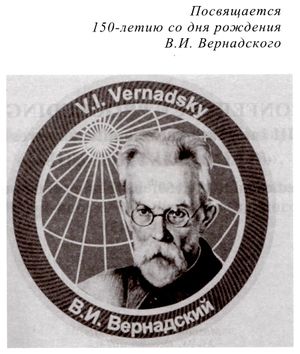
Vladimir Vernadsky was a geochemist and mineralogist from the Soviet Union. He was awarded the Stalin Prize in 1943 for his popular hypothesis on the Biosphere with Eduward Suess’. Vernadsky was the scientist who coined the term biogeochemistry, which is the study of physical, geological, chemical, and biological processes that govern the natural environment and the is the backbone of nutrient cycling. Many scientists have used different variations of the term.
Processes
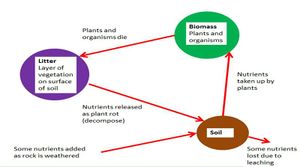
Litter Litter is the process of naturally occurring matter falling into a system. For example, Trees shed their leaves in the fall and grow them back in the spring. These leaves can have useful nutrients that can transfer into the soil, giving soil some fertility. Those leaves reenter into a cycle where nutrients are passed into soil. Litter can also come from other places like precipitation. Precipitation enters into the litter system and can be passed into the soil or leave the cycle through surface runoff. Litter that stays in the nutrient cycle mostly comes from decomposition into soil
Soil
Nutrients enter the soil through various ways. Soil is good at retaining nutrients and passing them to organisms that live in the soil. The small pores in the soil help retain the nutrients. Although soil can hold nutrients well there are still some ways where organic or inorganic matter can leave the cycle. One example is through leaching. Leaching is the process of a soluble mineral or chemical being lost from the soil as it travels into groundwater. Gravity and other factors play into leeching and take away nutrients from the soil. As that happens, certain bedrocks can emit good nutrients upward back into the soil. This uptake can benefit the soil and can enrich it. Nutrients within the soil can leave into biomass through plant uptake.
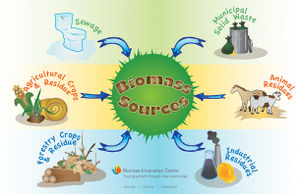
Biomass
The biomass includes things like crops, animals, municipal waster, and agricultural residues. Nutrients enter the biomass through systems like precipitation and plant uptake. nutrients can be stored in the biomass through plants.
Cycles Within And Associated With The Nutrient Cycle
Water Cycle The water cycle is highly complex and is anaccumilation of all hydrologic processes within the environment. The water cycle extends from groundwater flow to to condensation. It has a high influence over the nutrient cycle, as it plays a role in the movement of most nutrients.
Nitrogen Cycle
The nitrogen cycle moves nitrogen in and out of soil. It is important to the life and health of the soil as it carries amino acids and life itself. Nitrogen enters the soil through nitrogen fixation, the process of which nitrogen is converted into ammonia.
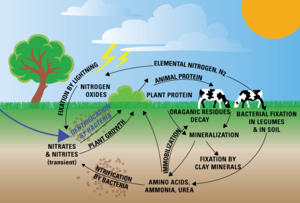
The Carbon Cycle Much like the nitrogen cycle, the carbon cycle sustains all life. Carbon is the basis for soil fertility as it release nutrients for plant growth and acts like riparian zone towards harmful substances. Carbon cycles through the environment similarly to the water cycle and the nitrogen cycle.
References
“The Nitrogen Cycle.” GeographyBase.com, Geography Bse, 16 Nov. 2017, geographybase.com/the-nitrogen-cycle.
“Nitrogen Cycle The Complete Process of Biogeochemical Cycle.” Biology, 18 Jan. 2018,
"The importance of Nitrogen" byjus.com/biology/nitrogen-cycle/.https://organicnz.org.nz/magazine-articles/role-importance-nitrogen-soil/
Bailey, Regina. ThoughtCo, www.thoughtco.com/all-about-the-nutrient-cycle-373411.
Nutrient Cycling, sci.waikato.ac.nz/farm/content/nutrientcycling.html.